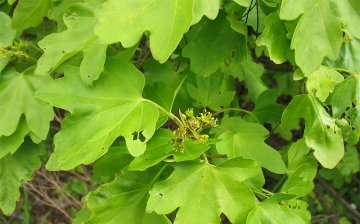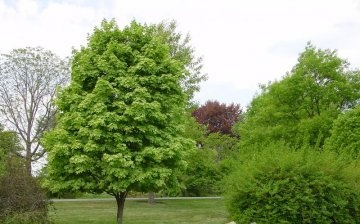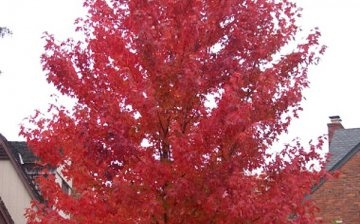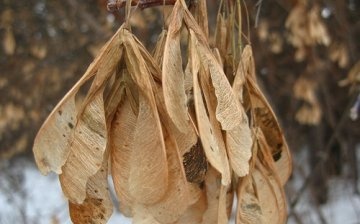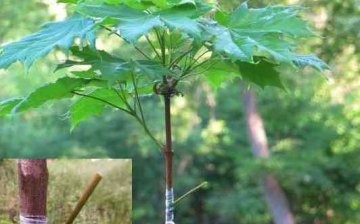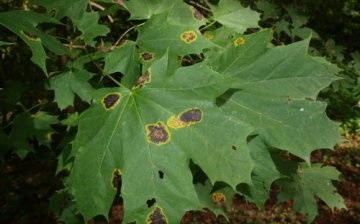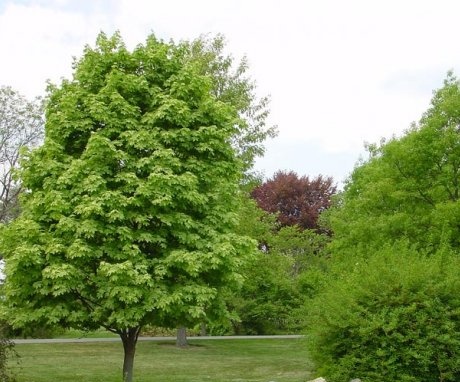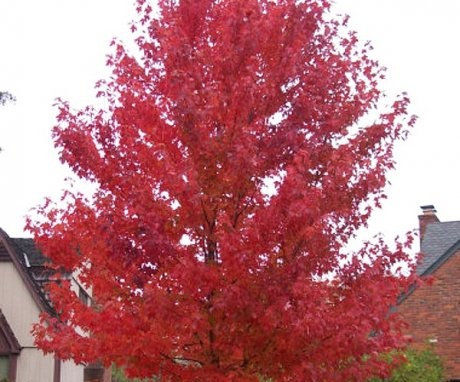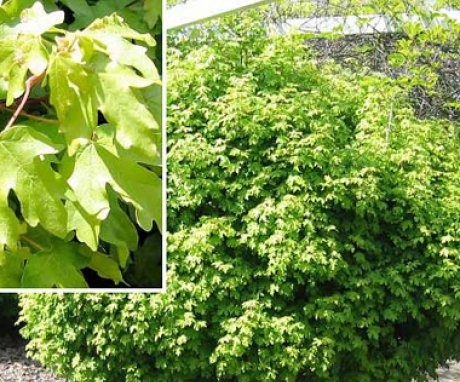Field maple - varieties, reproduction, grafting and proper care
In landscaping a site, garden or park, beautiful ornamental trees are mainly used. Conifers and evergreens are often used. Also, breeders have bred a large number of dwarf and decorative deciduous trees. One of which is maple... Many varieties have a beautiful crown shape, and their leaves turn red, yellow and orange colors and shades by autumn.
Content:
- General information about the field maple
- Varieties
- Care and landing
- Reproduction and grafting
- Diseases and pests
General information about the field maple
Field maple is a perennial plant that grows in the form of a tree and belongs to the maple family. Grows up to 15 meters. The crown is thick, oval in shape. The trunk is strong, straight, sometimes with slight curves. Its diameter can reach 60 cm. The trunk is covered with a thin grayish bark with characteristic longitudinal grooves. Root system wide, but not deep.
The field maple has decorative value due to its crown shape and foliage, which has from 3 to 5 blades, depending on the variety, and can be painted in all kinds of colors.
At an early age, the growth and expansion of the crown is significant, in older plants the growth increases by no more than 40 cm per year. It lends itself well to pruning and crown formation.
With the right planting site, the tree will live for more than 100 years. The homeland of this plant is considered to be the territory of Western Europe and Asia Minor, where maple grows in forest-steppe zones among deciduous trees.
Varieties
The best varieties to grow:
- Field maple "Elsric". It is a perennial deciduous tree with a height of 5-8 meters. The crown is dense, dense, oval in shape, its width reaches 3-5 meters in diameter. The leaves are large, carved, and consist of 5 lobes. Appear in April or early May and are reddish in spring. In the sun in the summer months, the leaves acquire a yellow color, in the shade they are green. By autumn, all the foliage becomes a rich yellow tone. The buds are collected in corymbose inflorescences, the petals are painted in a yellowish-green tone. The fruits are lionfish, appear at the end of summer, by autumn they acquire a nondescript brown tint. This variety of field maple has a high decorative value due to the seasonal color of the leaves. The tree is resistant to powdery mildew, drought tolerant and suitable for planting on city streets.
- Field maple "RedShine". It is a small tree with a height of only 5 meters. It has a rounded spreading crown, a medium-sized trunk with a grayish bark. The leaves are large, lobed, painted in a purple-red tone. In the spring, it blooms in a nondescript greenish-yellow tone. The buds are collected in small inflorescences.
- Field maple "Albovariegatum". This variety is a small bush, whose height reaches 5 meters. Often used as hedges... The trunks are strong, branching begins from the bottom. The bark is gray, with small longitudinal cracks. The leaves are large, lobed, painted in white-green, variegated tone. In the autumn, they turn yellow.
Care and landing
A well-lit place is chosen for planting a plant. The soil should be fertile, rich in humus, loose and well-drained. Stagnant water is bad for plant health.
Watering carried out regularly, especially in the hot summer. Field maple is well suited for planting on city streets, as it tolerates drought well. Therefore, when watering, it should be borne in mind that overflowing has a more detrimental effect on it than a lack of water. The soil under the tree must be loosened regularly so that the root system gets enough air. Weeds are also removed during weeding.
Landing:
- After choosing the right landing site, you need to prepare a hole.
- The depression should measure 50-70 cm in all directions, but not less than the size of the root system of the seedling.
- When planting, the root collar should be located at ground level, its slight deepening up to 5 cm is allowed.
It is recommended to prepare the soil mixture before planting the plant. To do this, humus, peat, river sand and compost are added to the ground from a dug hole. Mix everything well and pour a small amount into the well. When the tree is set, carefully fill in the remaining amount of substrate. After watering well and mulch the place of watering with peat or sawdust. Also, gardeners recommend adding a little during the first watering mineral fertilizers.
Maple does not need pruning due to its naturally correct crown structure.
It is necessary to inspect the plant annually for the presence of dry or diseased branches that are removed in the fall. Same pruning carried out when forming another crown shape, to decorate the site.
Reproduction and grafting
Field maple propagates using seed and green cuttings. For hybrid varieties, graft... The seeds can be purchased in specialty stores or collected from trees on their own, they retain the ability to germinate for 2 years.
Before sowing, it is necessary to prepare the material.
Under natural conditions, seeds fall from trees in strong winds and, due to their structure, spread over the nearest territory. There they land safely, covered with autumn foliage and winter snow. During the frost period, they pass stratification and the strongest seeds in the spring months, when the sun warms up and the snow melts, begin to hatch. At home, all these processes must be carried out independently.
Reproduction by seeds:
- After collecting, the seeds are dried a little, after which they must be placed at a temperature of 3-5 degrees Celsius for 3-3.5 months. A basement room or the bottom of the refrigerator, where vegetables are usually stored, works well for this process.
- The seeds are pre-wrapped in a damp, but not wet cloth. They need to be moistened periodically.
- You can also sow seeds in the fall, and they will go through the process of stratification in a natural way. This method has one drawback, it is impossible to trace the quality of the sown material.
- After storage the seeds are removed and soaked for 2-3 days in a stimulating solution. You can also preliminarily process a disinfectant, such as a weak solution of potassium permanganate.
- The prepared material can be planted in boxes with a fertile substrate.
- When the seeds hatch, they are planted in open ground. In warm weather, sowing can be carried out directly to the beds. More than 85% of crops usually germinate.
In the first year, young trees grow up to 80 cm in height. It is recommended to select a place with a small shade for germination so that the summer scorching sun does not dry out the plant. For seedlings it is necessary look after... Timely watering, feeding and loosening the soil. Transplant for a permanent place of growth, only seedlings that have reached 3 years of age are allowed.
Decorative hybrid varieties propagate by grafting:
- For this, you need to prepare the material. In the spring they cook cuttingsDuring the summer months, the vaccination process is carried out with the help of the kidneys.
- For the prepared cutting, an incision is made on a ripe young branch at an angle, a cut is made symmetrically at the graft and it is placed in the resulting hole. The place is well tied with a special film or tape.
- The bud is cut along with a part of the branch and placed in place of the freshly cut bud of a wild tree. The place is well rewound with a special tape or film.
- If shoots appear on the grafted branch or bud, then the process was successful. The fixing tape is not removed until next year, which will show the final result vaccinations... This will be seen by the buds and leaves that appear. For a good result, several grafts are made on one tree in different ways.
Reproduction is also carried out using green cuttings. To do this, in the summer, young ripe branches with 2-3 leaves on them are cut. Before disembarking them process several hours in stimulating solutions. Further, a loose fertile substrate is poured into a previously prepared container. The soil for planting can be prepared independently by mixing peat, river sand, turf and compost in equal proportions.
The cuttings are buried so that at least 2 buds are on the surface. After a while, the seedlings will take root, and they can be transferred to the beds for further development. It is recommended to plant them together with an earthen clod so as not to damage the young root system.
Diseases and pests
Basically, all decorative varieties of field maple are resistant to diseases... Aphids can attack the bottom of the pests. Since the tree is not fruitful, it can be processed with special drugs for the treatment and removal of troubles. It is recommended to carry out preventive work in the garden with decorative plantings in the spring.
Also, diseases can occur with improper care, excess water or mineral fertilizers... In this case, it is necessary to adjust the leaving process. In regular rainy weather, weeding is recommended after each irrigation. Thus, excess water will naturally go to the ground.
Field maple is widely used in landscaping parks and squares.
It is also often used to create hedges. For this, hybrid low varieties that grow in the form of a bush are well suited. Thanks to its beautiful leaves and their coloration, the tree looks decorative from early spring to late autumn.
More information can be found in the video.



